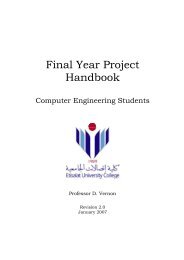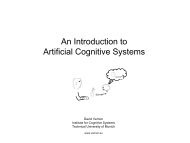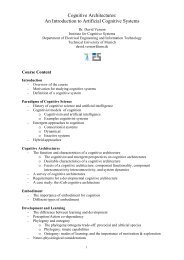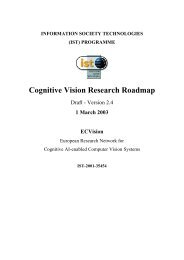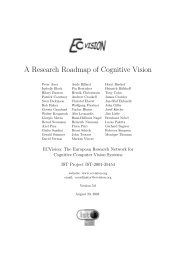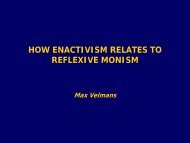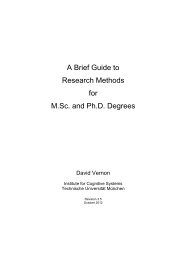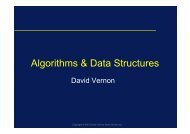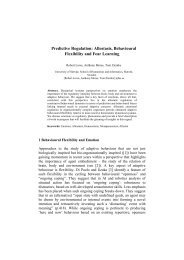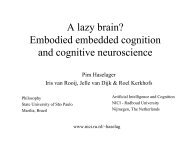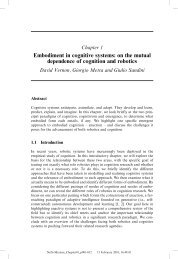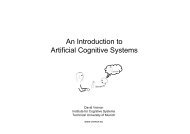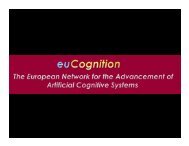Lecture 2: Paradigms of Cognitive Science - David Vernon
Lecture 2: Paradigms of Cognitive Science - David Vernon
Lecture 2: Paradigms of Cognitive Science - David Vernon
You also want an ePaper? Increase the reach of your titles
YUMPU automatically turns print PDFs into web optimized ePapers that Google loves.
An Introduction to<br />
Artificial <strong>Cognitive</strong> Systems<br />
<strong>David</strong> <strong>Vernon</strong><br />
Institute for <strong>Cognitive</strong> Systems<br />
Technical University <strong>of</strong> Munich<br />
www.vernon.eu<br />
Copyright © 2012 <strong>David</strong> <strong>Vernon</strong>
<strong>Lecture</strong> 2<br />
<strong>Paradigms</strong> <strong>of</strong> <strong>Cognitive</strong> <strong>Science</strong><br />
Copyright © 2012 <strong>David</strong> <strong>Vernon</strong>
<strong>Cognitive</strong> <strong>Science</strong><br />
Cybernetics<br />
1943-53<br />
Cognitivism<br />
1956-<br />
(AI)<br />
Emergent Systems<br />
1958-<br />
Network Dynamics<br />
Synergetics<br />
Dynamical Systems Theory<br />
Enactive Systems<br />
1970-<br />
[Varela 88]<br />
Copyright © 2012 <strong>David</strong> <strong>Vernon</strong>
COGNITION<br />
Self-Organization<br />
Cognitivist<br />
Hybrid<br />
Emergent<br />
Physical Symbol Systems<br />
Newell’s Unified Theories<br />
<strong>of</strong> Cognition<br />
Computational paradigm<br />
Dynamical<br />
Systems<br />
Connectionist<br />
Systems<br />
Enactive<br />
Systems<br />
Copyright © 2012 <strong>David</strong> <strong>Vernon</strong>
Some Background<br />
on<br />
Cybernetics<br />
Copyright © 2012 <strong>David</strong> <strong>Vernon</strong>
Cybernetics<br />
• The word cybernetics has its roots in the Greek word κυβερνητης or<br />
kybernetes, meaning steersman<br />
• It was defined in Norbert Wiener’s book Cybernetics, first published<br />
in 1948, as “the science <strong>of</strong> control and communication” (this was the<br />
sub-title <strong>of</strong> the book)<br />
• W. Ross Ashby notes in his book An Introduction to Cybernetics,<br />
published in 1956 that cybernetics is essentially “the art <strong>of</strong><br />
steersmanship”<br />
– co-ordination, regulation, and control.<br />
• The word governor derives from gubernator, the Latin version <strong>of</strong><br />
κυβερνητης<br />
Copyright © 2012 <strong>David</strong> <strong>Vernon</strong>
Cybernetics<br />
• The word cybernetics has its roots in the Greek word κυβερνητης or<br />
kybernetes, meaning steersman<br />
• It was defined in Norbert Wiener’s book Cybernetics, first published<br />
in 1948, as “the science <strong>of</strong> control and communication” (this was the<br />
sub-title <strong>of</strong> the book)<br />
• W. Ross Ashby notes in his book An Introduction to Cybernetics,<br />
published in 1956 that cybernetics is essentially “the art <strong>of</strong><br />
steersmanship”<br />
– co-ordination, regulation, and control.<br />
• The word governor derives from gubernator, the Latin version <strong>of</strong><br />
κυβερνητης<br />
Copyright © 2012 <strong>David</strong> <strong>Vernon</strong>
Cybernetics<br />
• Closed-loop control<br />
• An action by the system causes some change in its environment<br />
and that change is fed to the system via feedback that enables the<br />
system to change its behaviour<br />
• This "circular causal" relationship is necessary and sufficient for a<br />
cybernetic perspective [Wikipedia]<br />
Copyright © 2012 <strong>David</strong> <strong>Vernon</strong>
Cybernetics<br />
• “The essential goal <strong>of</strong> cybernetics is to understand and define the<br />
functions and processes <strong>of</strong> systems that have goals and that<br />
participate in circular, causal chains that move from action to<br />
sensing to comparison with desired goal, and again to action.”<br />
[Wikipedia]<br />
Copyright © 2012 <strong>David</strong> <strong>Vernon</strong>
Cybernetics<br />
• Recent definition proposed by Louis Kauffman, President <strong>of</strong> the<br />
American Society for Cybernetics<br />
"Cybernetics is the study <strong>of</strong> systems and processes that interact with<br />
themselves and produce themselves from themselves."<br />
Copyright © 2012 <strong>David</strong> <strong>Vernon</strong>
COGNITION<br />
Self-Organization<br />
Cognitivist<br />
Hybrid<br />
Emergent<br />
Physical Symbol Systems<br />
Newell’s Unified Theories<br />
<strong>of</strong> Cognition<br />
Computational paradigm<br />
Dynamical<br />
Systems<br />
Connectionist<br />
Systems<br />
Enactive<br />
Systems<br />
Copyright © 2012 <strong>David</strong> <strong>Vernon</strong>
Different <strong>Paradigms</strong> <strong>of</strong><br />
<strong>Cognitive</strong> Systems<br />
The Cognitivist Approach<br />
Information Processing<br />
Physical Symbol Systems<br />
Representationist Approach<br />
Copyright © 2012 <strong>David</strong> <strong>Vernon</strong>
‘The world we perceive is isomorphic with our perceptions <strong>of</strong> it<br />
as a geometric environment’<br />
[Shepard & Hurwitz ‘84]<br />
Copyright © 2012 <strong>David</strong> <strong>Vernon</strong>
‘Cognition is a type <strong>of</strong> computation’<br />
‘People “instantiate” … representations physically as cognitive<br />
codes and that their behaviour is a causal consequence <strong>of</strong><br />
operations carried out on these codes’<br />
[Pylyshyn ‘84]<br />
Copyright © 2012 <strong>David</strong> <strong>Vernon</strong>
From The Tree <strong>of</strong> Knowledge – The Biological Roots <strong>of</strong> Human Understanding<br />
H. R. Maturana and F. J. Varela, 1988<br />
Copyright © 2012 <strong>David</strong> <strong>Vernon</strong>
Cognitivist Systems<br />
• Strong representations<br />
– Explicit & symbolic<br />
– Representations denote external objects<br />
– Isomorphic<br />
– Projection<br />
– Implies an absolute and accessible ontology<br />
– That is consistent with human expression …<br />
Copyright © 2012 <strong>David</strong> <strong>Vernon</strong>
Copyright © 2012 <strong>David</strong> <strong>Vernon</strong>
Cognitivist Systems<br />
• Representations<br />
– Descriptive product <strong>of</strong> a human designer<br />
– Can be directly accessed & understood by humans<br />
– Human knowledge can be directly injected into an<br />
artificial cognitive system<br />
Copyright © 2012 <strong>David</strong> <strong>Vernon</strong>
Cognitivist Systems<br />
• But …<br />
Programmer-dependent representations bias the system<br />
‘blind’ the system (cf. Winograd & Flores)<br />
• … can you anticipate every eventuality in your design?<br />
• The semantic gap … and the Symbol Grounding problem<br />
Copyright © 2012 <strong>David</strong> <strong>Vernon</strong>
Cognitivist Systems<br />
• Plugging the gap by …<br />
– Machine learning<br />
– Probabilistic modelling<br />
– Better models<br />
– Better logics<br />
– Better reasoning<br />
– Better everything<br />
– … and still …<br />
Copyright © 2012 <strong>David</strong> <strong>Vernon</strong>
<strong>Cognitive</strong> science<br />
is involved in an escalating retreat<br />
from the inner symbol:<br />
a kind <strong>of</strong> inner symbol flight<br />
A. Clark, Mindware<br />
Copyright © 2012 <strong>David</strong> <strong>Vernon</strong>
Cognitivism and Artificial Intelligence<br />
Copyright © 2012 <strong>David</strong> <strong>Vernon</strong>
Cognitivism & Artificial Intelligence<br />
• Physical symbol system approach to AI<br />
• Intelligence<br />
– The degree to which a system approximates a knowledge-level system<br />
[Unified Theories <strong>of</strong> Cognition, Newell 90]<br />
– A knowledge-level system: can bring all its knowledge to bear on every<br />
problem<br />
• Perfect knowledge -> complete use <strong>of</strong> knowledge<br />
• Humans aren’t there yet!!<br />
– Principle <strong>of</strong> maximum rationality [Newell 82]<br />
• ‘If an agent has knowledge that one <strong>of</strong> its actions will lead to one <strong>of</strong> its goals,<br />
then the agent will select that action’<br />
– Rational analysis [Anderson 89]<br />
• ‘The cognitive system optimizes the adaptation <strong>of</strong> the behaviour <strong>of</strong> the<br />
organism’.<br />
Copyright © 2012 <strong>David</strong> <strong>Vernon</strong>
Cognitivism & Artificial Intelligence<br />
• Physical Symbol Systems<br />
– Symbols are abstract entities that can be instantiated as tokens<br />
– A physical symbol system has [Newell 90]:<br />
• Memory (to contain the symbolic information)<br />
• Symbols (to provide a pattern to match or index other symbols)<br />
• Operations (to manipulate symbols)<br />
• Interpretations (to allow symbols to specify operations)<br />
• Capacities for<br />
– Composability<br />
– Interpretability<br />
– Sufficient memory<br />
– Symbol systems can be instantiated but … behaviour is<br />
independent <strong>of</strong> the particular form <strong>of</strong> the instantiation<br />
Copyright © 2012 <strong>David</strong> <strong>Vernon</strong>
Cognitivism & Artificial Intelligence<br />
• Physical Symbol Systems [Newell and Simon 1975]<br />
– The Physical Symbol System Hypothesis<br />
• A physical symbol system has the necessary and sufficient means for<br />
general intelligent action<br />
• Any system that exhibits general intelligence is a physical symbol<br />
system<br />
• A physical symbol system is ‘a machine that produces through time an<br />
evolving collection <strong>of</strong> symbol structures’<br />
Copyright © 2012 <strong>David</strong> <strong>Vernon</strong>
Cognitivism & Artificial Intelligence<br />
• Physical Symbol Systems [Newell and Simon 1975]<br />
Symbol Systems<br />
comprise<br />
comprise<br />
Symbol Structures /<br />
Expresssions /<br />
Patterns<br />
Produce, destroy, modify<br />
Processes<br />
designate<br />
Objects<br />
designate<br />
Processes<br />
Can affect objects<br />
Can be affected by objects<br />
Can be interpreted: carry out the designated process<br />
Copyright © 2012 <strong>David</strong> <strong>Vernon</strong>
Cognitivism & Artificial Intelligence<br />
• Physical Symbol Systems [Newell and Simon 1975]<br />
– The Heuristic Search Hypothesis<br />
• The solutions to problems are represented as symbol structures<br />
• A physical symbol system exercises its intelligence in problem-solving<br />
by search<br />
– Generating and progressively modifying symbol structures until ti produces<br />
a solution structure<br />
– Effective and efficient search<br />
• ‘The task <strong>of</strong> intelligence is to avert the ever-present threat <strong>of</strong> the<br />
exponential explosion <strong>of</strong> search’<br />
Copyright © 2012 <strong>David</strong> <strong>Vernon</strong>
Cognitivism & Artificial Intelligence<br />
• Physical Symbol Systems<br />
– The Physical Symbol System Hypothesis<br />
A physical symbol system has the necessary and sufficient means<br />
<strong>of</strong> general intelligence<br />
– What are the implications for humans???<br />
– Natural and artifical intelligence is equivalent (why?)<br />
Copyright © 2012 <strong>David</strong> <strong>Vernon</strong>
Cognitivism & Artificial Intelligence<br />
Newell’s four levels<br />
Social<br />
10 5 –10 7 s; behaviours<br />
Requires a symbolic level<br />
Rational<br />
10 2 –10 4 s; tasks requiring reasoning (find way home)<br />
<strong>Cognitive</strong><br />
10 -1 –10 1 s; deliberate acts (reaching),<br />
composed operations (shifting gear)<br />
actions (steering a car into a gate)<br />
Biological<br />
10 -4 –10 -2 s; organelle, neuron, neural circuit<br />
All knowledge is here<br />
Copyright © 2012 <strong>David</strong> <strong>Vernon</strong>
Cognitivism & Artificial Intelligence<br />
• (<strong>Cognitive</strong>) Architecture: defines the manner in which a cognitive agent<br />
manages the primitive resources at its disposal<br />
• Dictates representations and their deployment<br />
• Dictates properties <strong>of</strong> cognitive system<br />
– Organization & control strategies (coordination/cooperation;<br />
modular/hierarchical)<br />
– Memory, knowledge, representation (world models, delarative<br />
representations, procedural representations, associate memory, episodic<br />
knowledge, meta-knowledge, represenational structures)<br />
– Types <strong>of</strong> learning (deliberative vs reflexive; monotonic vs non-monotonic)<br />
– Types <strong>of</strong> planning<br />
– Behaviour (coherence, saliency, & adequacy: consistency, relevance,<br />
sufficiency)<br />
Copyright © 2012 <strong>David</strong> <strong>Vernon</strong>
Cognitivism & Artificial Intelligence<br />
• Unified Theories <strong>of</strong> Cognition<br />
– Attempts to explain all the mechanisms <strong>of</strong> all problems in its<br />
domain<br />
– Now plausible (Newell) cf the Soar project<br />
– Applies to both natural and artificial cognition<br />
Copyright © 2012 <strong>David</strong> <strong>Vernon</strong>
Cognitivism & Artificial Intelligence<br />
• Non-functional Attributes <strong>of</strong> <strong>Cognitive</strong> Architectures<br />
– Generality (breadth <strong>of</strong> tasks)<br />
– Versatility (ibid)<br />
– Rationality (cf. consistency and repeatability)<br />
– Scalability (cf. complexity)<br />
– Reactivity (cf. unpredictability)<br />
– Efficiency (cf. time and space constraints)<br />
– Extendability (cf. reconfigurability)<br />
– Taskability (cf. external direction)<br />
– Psychological validity (cf. human models)<br />
Copyright © 2012 <strong>David</strong> <strong>Vernon</strong>
Copyright © 2012 <strong>David</strong> <strong>Vernon</strong>
Different <strong>Paradigms</strong> <strong>of</strong><br />
<strong>Cognitive</strong> Systems<br />
Emergent Approaches<br />
Copyright © 2012 <strong>David</strong> <strong>Vernon</strong>
COGNITION<br />
Self-Organization<br />
Cognitivist<br />
Hybrid<br />
Emergent<br />
Physical Symbol Systems<br />
Newell’s Unified Theories<br />
<strong>of</strong> Cognition<br />
Computational paradigm<br />
Dynamical<br />
Systems<br />
Connectionist<br />
Systems<br />
Enactive<br />
Systems<br />
Copyright © 2012 <strong>David</strong> <strong>Vernon</strong>
Self-generated AI:<br />
AI by orchestrating the processes that generate it<br />
Luc Steels<br />
Copyright © 2012 <strong>David</strong> <strong>Vernon</strong>
Emergent Approaches<br />
• Cognition is the process whereby an autonomous system<br />
becomes viable and effective in its environment<br />
• It does so through a process <strong>of</strong> self-organization<br />
– System is continually re-constituting itself<br />
– In real-time<br />
– To maintain it operational identity<br />
– Through moderation <strong>of</strong> mutual system-environment interaction and<br />
co-determination<br />
Maturana & Varela 87<br />
Copyright © 2012 <strong>David</strong> <strong>Vernon</strong>
• Co-determination<br />
Emergent Approaches<br />
– <strong>Cognitive</strong> agent is specified by its environment<br />
– <strong>Cognitive</strong> process determines what is real or meaningful for the<br />
agent<br />
– The system constructs its reality (world) as a result <strong>of</strong> its operation<br />
in that world<br />
– Perception provides sensory data to enable effective action, but as<br />
a consequence <strong>of</strong> the system’s actions<br />
– Cognition and perception are functionally-dependent on the<br />
richness <strong>of</strong> the action interface [Granlund]<br />
Copyright © 2012 <strong>David</strong> <strong>Vernon</strong>
Emergent Approaches<br />
• Cognition is the complement <strong>of</strong> perception [Sandini]<br />
– Perception deal with the immediate<br />
– Cognition deals with longer time frames<br />
• Primate model <strong>of</strong> cognitive learning is anticipative skill construction<br />
(not knowledge acquisition)<br />
• The root <strong>of</strong> intelligence is the ability to guide action and, at the same<br />
time, improve that ability<br />
• Embodied as physical systems capable <strong>of</strong> physical interaction with the<br />
world<br />
Copyright © 2012 <strong>David</strong> <strong>Vernon</strong>
Emergent Approaches<br />
‘<strong>Cognitive</strong> systems need to acquire information about the external<br />
world through learning or association’<br />
[Granlund’02]<br />
Copyright © 2012 <strong>David</strong> <strong>Vernon</strong>
Copyright © 2012 <strong>David</strong> <strong>Vernon</strong>
Emergent Approaches<br />
• Self-organization<br />
– “Self-organizing systems are physical and biological systems in which<br />
pattern and structure at the global level arises solely from interactions<br />
among the lower-level components <strong>of</strong> the system.”<br />
– “The rules specifying interactions among the system’s components are<br />
executed only using local information, without reference to the global<br />
pattern.”<br />
• Emergence<br />
– A process by which a system <strong>of</strong> interacting elements acquires qualitatively<br />
new pattern and structure that cannot be understood simply as the<br />
superposition <strong>of</strong> the individual contributions.<br />
Camazine 2006<br />
Copyright © 2012 <strong>David</strong> <strong>Vernon</strong>
• Self-organization<br />
Emergent Approaches<br />
– Short-range Activator<br />
• autocatalysis: promote its own productions<br />
• Increase the production <strong>of</strong> an inhibitor (antagonist)<br />
– Inhibitor<br />
• Diffuses rapidly<br />
– Result:<br />
• Local increase in activation<br />
• Long-range antagonistic inhibition which keeps the self-enhancing<br />
reaction localized<br />
Camazine 2006<br />
Copyright © 2012 <strong>David</strong> <strong>Vernon</strong>
Emergent Approaches<br />
Local autocatalysis<br />
Non-local negative feedback<br />
Meinhardt 95<br />
Copyright © 2012 <strong>David</strong> <strong>Vernon</strong>
Emergent Approaches<br />
Camazine 2006<br />
Copyright © 2012 <strong>David</strong> <strong>Vernon</strong>
Connectionist Systems<br />
Copyright © 2012 <strong>David</strong> <strong>Vernon</strong>
Connectionist Systems<br />
• Rely on<br />
– Parallel processing<br />
– Non-symbolic distributed activation patterns in networks<br />
– Not logical rules<br />
• Neural networks are the most common instantiations<br />
– Dynamical systems that capture statistical regularities or<br />
associations<br />
Copyright © 2012 <strong>David</strong> <strong>Vernon</strong>
Dynamical Systems<br />
Copyright © 2012 <strong>David</strong> <strong>Vernon</strong>
COGNITION<br />
Self-Organization<br />
Cognitivist<br />
Hybrid<br />
Emergent<br />
Physical Symbol Systems<br />
Newell’s Unified Theories<br />
<strong>of</strong> Cognition<br />
Computational paradigm<br />
Dynamical<br />
Systems<br />
Connectionist<br />
Systems<br />
Enactive<br />
Systems<br />
Copyright © 2012 <strong>David</strong> <strong>Vernon</strong>
• Dynamical Systems<br />
Dynamical Systems<br />
– A dynamical system is an open dissipative non-linear non-equilibrium<br />
system<br />
– System: large number <strong>of</strong> interacting components & large number <strong>of</strong><br />
degrees <strong>of</strong> freedom<br />
– Dissipative: diffuse energy – phase space decreased in volume with<br />
time (⇨ preferential sub-spaces)<br />
– Non-equilibrium: unable to maintain structure or function without<br />
external sources <strong>of</strong> energy, material, information (hence, open)<br />
– Non-linearity: dissipation is not uniform – small number <strong>of</strong> system’s<br />
degrees <strong>of</strong> freedom contribute to behaviour<br />
• Order parameters / collective variables<br />
Kelso ‘95: Dynamic Pattern – The Self-Organization <strong>of</strong> Brain and Behaviour<br />
Copyright © 2012 <strong>David</strong> <strong>Vernon</strong>
Dynamical System<br />
q = N(q, p, n)<br />
time derivative<br />
state vector<br />
noise<br />
control parameters<br />
From [Shoner Kelso 88]<br />
Copyright © 2012 <strong>David</strong> <strong>Vernon</strong>
Enactive Systems<br />
Copyright © 2012 <strong>David</strong> <strong>Vernon</strong>
Enaction<br />
• Orthodoxy (cognitivist)<br />
– World as the system experiences it is independent <strong>of</strong> the cognitive<br />
system (knower)<br />
• Enactive view<br />
– Known and knower ‘stand in relation to each other as mutual<br />
specification: they arise together’<br />
Copyright © 2012 <strong>David</strong> <strong>Vernon</strong>
Enaction<br />
• Five key elements to enactive systems<br />
– Autonomy<br />
– Embodiment<br />
– Emergence<br />
– Experience<br />
– Sense-making<br />
Copyright © 2012 <strong>David</strong> <strong>Vernon</strong>
Enaction<br />
• Autonomy<br />
– Self-maintenance<br />
– Homeostasis<br />
– Not controlled by outside agencies<br />
– Stands apart from its environment<br />
Copyright © 2012 <strong>David</strong> <strong>Vernon</strong>
Enaction<br />
• Embodiment<br />
– Exists as a physical entity<br />
– Directly interacts with its environment<br />
• Structural coupling<br />
• Mutual perturbation<br />
– Constitutive part <strong>of</strong> the cognitive process<br />
Copyright © 2012 <strong>David</strong> <strong>Vernon</strong>
Enaction<br />
• Emergence<br />
– <strong>Cognitive</strong> behaviour arises from dynamic interplay between<br />
component parts<br />
– Internal dynamics<br />
• Maintains autonomy<br />
• Condition the system’s experiences through their embodiment in a<br />
specific structure<br />
Copyright © 2012 <strong>David</strong> <strong>Vernon</strong>
Enaction<br />
• Experience<br />
– History <strong>of</strong> interaction with the world<br />
– Interactions don’t control<br />
– Interaction do trigger changes in system state<br />
– Changes are structurally-determined<br />
• Phylogeny<br />
• Structural coupling<br />
Copyright © 2012 <strong>David</strong> <strong>Vernon</strong>
Enaction<br />
• Sense-making<br />
– Knowledge is generated by the system itself<br />
– Captures some regularity or lawfulness in the interactions<br />
– The ‘sense’ is dependent on the way interaction can take place<br />
• Perception & Action<br />
– Modify its own state (CNS) to enhance<br />
• Predictive capacity<br />
• Action capabilities<br />
– Development: generative autonomous self-modification<br />
Copyright © 2012 <strong>David</strong> <strong>Vernon</strong>
Development<br />
Progressive ontogenetic acquisition <strong>of</strong> anticipatory capabilities<br />
– Cognition cannot short-circuit ontogeny<br />
– Necessarily the product <strong>of</strong> a process <strong>of</strong> embodied development<br />
– Initially dealing with immediate events<br />
t<br />
– Increasingly acquiring a predictive capability<br />
t<br />
Cognition and perception are functionally-dependent<br />
on the richness <strong>of</strong> the action interface<br />
Copyright © 2012 <strong>David</strong> <strong>Vernon</strong>
Co-determination / Structural Coupling<br />
Autonomony-preserving mutual interaction<br />
Perturbation <strong>of</strong> the system is only effected by the environment<br />
[Note: this ideogram and similar ones to follow were introduced in Maturana and Varela 1987]<br />
Copyright © 2012 <strong>David</strong> <strong>Vernon</strong>
<strong>Cognitive</strong> system: operationally-closed system with a nervous system<br />
Nervous system facilitates a highly-plastic mapping between<br />
sensor and motor surfaces<br />
Perturbation by both environment and system (<strong>of</strong> receptors & NS)<br />
Copyright © 2012 <strong>David</strong> <strong>Vernon</strong>
Enaction<br />
NERVOUS SYSTEM<br />
(a) Facilitates huge increase in the number <strong>of</strong> possible<br />
sensor-motor patterns (that result from structural coupling<br />
with the environment)<br />
(b) Creates new dimensions (DoF) <strong>of</strong> structural coupling<br />
by facilitating association <strong>of</strong> internal states with the<br />
interactions in which the system is engaged<br />
Copyright © 2012 <strong>David</strong> <strong>Vernon</strong>
t<br />
t<br />
Anticipation / Planning / Explanation / Prediction<br />
Copyright © 2012 <strong>David</strong> <strong>Vernon</strong>
INTERACTION<br />
A shared activity in which the actions <strong>of</strong> each agent<br />
Influence the actions <strong>of</strong> the other agents in the same interaction<br />
Resulting in a mutually-constructed pattern <strong>of</strong> shared behaviour<br />
[Ogden et al.]<br />
Copyright © 2012 <strong>David</strong> <strong>Vernon</strong>
Meaning emerges through shared consensual<br />
experience mediated by interaction<br />
Interaction is a shared activity in which the actions <strong>of</strong> each agent<br />
influence the actions <strong>of</strong> the other agents engaged in the same<br />
interaction, resulting in a mutually-constructed patterns <strong>of</strong> shared<br />
behaviour<br />
Ogden, Dautenhahn, Stribling 2002<br />
Copyright © 2012 <strong>David</strong> <strong>Vernon</strong><br />
Bond <strong>of</strong> Union<br />
M. C. Escher, 1956
COGNITION & SENSE-MAKING<br />
Cognition is a process whereby the issues that are important<br />
for the continued existence <strong>of</strong> the cognitive entity<br />
are brought forth: co-determined by the entity as it interacts<br />
with the environment in which it is embedded<br />
Copyright © 2012 <strong>David</strong> <strong>Vernon</strong>
THE SPACE OF PERCEPTUAL POSSIBILITIES<br />
Is predicated not on an objective environment,<br />
but on the space <strong>of</strong> possible actions<br />
that the system can engage in whilst still<br />
maintaining the consistency <strong>of</strong> its coupling with the environment<br />
Copyright © 2012 <strong>David</strong> <strong>Vernon</strong>
Copyright © 2012 <strong>David</strong> <strong>Vernon</strong>
Enaction<br />
• Autopoiesis<br />
– Autopoiesis is a special type <strong>of</strong> self-organization<br />
– Requires self-specification and self-generation<br />
(autopoiesis means literally `self-production')<br />
– An autopoietic system is a special type <strong>of</strong> homeostatic<br />
system (i.e. self-regulating system)<br />
• regulation applies not to some system parameter<br />
• but to the organization <strong>of</strong> the system itself.<br />
Copyright © 2012 <strong>David</strong> <strong>Vernon</strong>
Enaction<br />
• Autopoiesis<br />
– Thus, its organization is constituted by relations between<br />
components that by their interaction and transformation<br />
continuously regenerate the network <strong>of</strong> processes that<br />
produce them<br />
– That is, the relations among components -- a network <strong>of</strong><br />
processes <strong>of</strong> production --- produce the components<br />
themselves<br />
– A significant aspect <strong>of</strong> autopoiesis is that its function is to<br />
`create and maintain the unity that distinguishes it from the<br />
medium in which it exists'.<br />
Copyright © 2012 <strong>David</strong> <strong>Vernon</strong>
Enaction<br />
• Autopoiesis<br />
– Self-production<br />
– System emerges as a coherent systemic entity, distinct from<br />
its environment, as a consequence <strong>of</strong> processes <strong>of</strong> selforganization<br />
– Three orders <strong>of</strong> system …<br />
Copyright © 2012 <strong>David</strong> <strong>Vernon</strong>
Enaction<br />
• Autopoiesis<br />
– First-order autopoietic systems correspond to cellular<br />
entities that achieve physical identity through structural<br />
coupling with the environment:<br />
Environmental perturbations trigger structural changes that<br />
permit it to continue operating<br />
Copyright © 2012 <strong>David</strong> <strong>Vernon</strong>
Enaction<br />
• Autopoiesis<br />
– Second-order systems correspond to meta-cellular entities<br />
that exhibit autopoiesis through operational closure in their<br />
organization<br />
They specify a network <strong>of</strong> dynamic processes that don’t<br />
leave the network (organizationally closed)<br />
Engage in structural coupling with the environment, this time<br />
with a nervous system ( -> much enlarged space <strong>of</strong> internal<br />
states & much enlarge space <strong>of</strong> interaction)<br />
– <strong>Cognitive</strong> systems (at agent level)<br />
Copyright © 2012 <strong>David</strong> <strong>Vernon</strong>
Enaction<br />
• Autopoiesis<br />
– Third-order systems exhibit coupling between second-order<br />
(cognitive) systems<br />
– Common ontogenetic drift between reciprocally-coupled<br />
systems<br />
– Shared epistemology / language<br />
• Reflects but does not abstract the common medium in which<br />
they are coupled<br />
– 3 types <strong>of</strong> behaviour<br />
• Instinctive behaviour (based on autopoietic self-organization)<br />
• Ontogenic behaviour (based on its development)<br />
• Communication / social behaviour<br />
Copyright © 2012 <strong>David</strong> <strong>Vernon</strong>
Enaction<br />
• Autopoiesis<br />
– Linguistic behaviours: intersection <strong>of</strong> ontogenic and<br />
communication behaviours<br />
– Facilitates creation <strong>of</strong> a common understanding <strong>of</strong> a shared<br />
world (in which they are coupled)<br />
– Language is an emergent consequence <strong>of</strong> the third-order<br />
structural coupling <strong>of</strong> a socially-cohesive group <strong>of</strong> cognitive<br />
entities<br />
Copyright © 2012 <strong>David</strong> <strong>Vernon</strong>
Enaction<br />
• Autopoiesis<br />
– Consciousness (mind) emerges when language and<br />
linguistic behaviour is applied recursively to the agent itself<br />
– Consciousness is an emergent property <strong>of</strong> social coupling<br />
– Doesn’t have any independent existence (and you can’t<br />
model it!)<br />
Copyright © 2012 <strong>David</strong> <strong>Vernon</strong>
Enaction<br />
• Third-order systems: coupling between second-order<br />
(cognitive) systems<br />
– Recurrent (common) ontogenic drift from reciprocal coupling<br />
– Instinctive behaviour based on second-order organization<br />
(phylogenic evolution)<br />
– Ontogenetic behaviour, development qua learning over its lifetime<br />
– Communicative behaviour: third order structural coupling (social<br />
coupling)<br />
– Linguistic behaviours: establishment <strong>of</strong> a shared epistemology<br />
Copyright © 2012 <strong>David</strong> <strong>Vernon</strong>
The Hierarchy <strong>of</strong> Enactive Systems<br />
Same approach: operational closure<br />
Emergence <strong>of</strong> Language:<br />
Explicit deliberative self-reflective reasoning<br />
Rationalization <strong>of</strong><br />
interactions & perceptions:<br />
2<br />
Intelligent<br />
(adaptive & anticipatory)<br />
behaviour 1<br />
3<br />
Societies <strong>of</strong><br />
<strong>Cognitive</strong> Entities<br />
Viable Organisms<br />
Emergence <strong>of</strong> Cognition<br />
Cellular Organization<br />
Physical Instantiation<br />
Structural coupling with<br />
the environment<br />
Multilevel Autopoeitic / <strong>Cognitive</strong> Systems<br />
Copyright © 2012 <strong>David</strong> <strong>Vernon</strong>
Enactive Cognition<br />
MEANING<br />
Emerges through shared consensual experience<br />
mediated by interaction<br />
Copyright © 2012 <strong>David</strong> <strong>Vernon</strong>
Copyright © 2012 <strong>David</strong> <strong>Vernon</strong>
Copyright © 2012 <strong>David</strong> <strong>Vernon</strong>
Enactive Cognition<br />
• Structural coupling<br />
– Necessarily embodied<br />
– Operating in synchronous real-time<br />
Machine representations reflect<br />
the machine’s epistemology<br />
Copyright © 2012 <strong>David</strong> <strong>Vernon</strong>
Enactive Cognition<br />
Need to achieve synthetic cognition without falling back into using<br />
cognitivist preconceptions basing the ‘design’ on representations<br />
derived by external observers (us)<br />
Copyright © 2012 <strong>David</strong> <strong>Vernon</strong>
Bickhard’s Self-Maintenant &<br />
Recursive Self-Maintenant Systems<br />
Copyright © 2012 <strong>David</strong> <strong>Vernon</strong>
Emergent Models<br />
• “The grounds for cognition are adaptive far-fromequilibrium<br />
autonomy – recursively self-maintenant<br />
autonomy – not symbol processing nor connectionist<br />
input processing.”<br />
Copyright © 2012 <strong>David</strong> <strong>Vernon</strong>
Emergent Models<br />
• Autonomy: the property <strong>of</strong> a system to contribute to<br />
its own persistence<br />
• Different grades <strong>of</strong> contribution -> different levels <strong>of</strong><br />
autonomy<br />
Copyright © 2012 <strong>David</strong> <strong>Vernon</strong>
• Self-maintenant Systems<br />
Emergent Models<br />
– Make active contributions to its own persistence<br />
– Do not contribute to the maintenance <strong>of</strong> the conditions for<br />
persistence<br />
Copyright © 2012 <strong>David</strong> <strong>Vernon</strong>
Emergent Models<br />
• Recursive self-maintenant systems<br />
– Do contribute actively to the conditions for persistence<br />
– Can deploy different processes <strong>of</strong> self-maintenance<br />
depending on environmental conditions<br />
– “they shift their self-maintenant processes so as to maintain<br />
self-maintenance as the environment shifts” !!!<br />
Copyright © 2012 <strong>David</strong> <strong>Vernon</strong>
Emergent Models<br />
• Far from equilibrium stability<br />
– Non-thermodynamic equilibrium<br />
– Requires that the system does NOT go to thermodynamic<br />
equilibrium<br />
– Completely dependent on their continued existence on continued<br />
contributions from external factors<br />
– Do require environmental interaction<br />
– Necessarily open processes (which exhibit closed organization)<br />
Copyright © 2012 <strong>David</strong> <strong>Vernon</strong>
Emergent Models<br />
• Self-maintenant and recursive self-maintenant systems are both<br />
far-from-equilibrium systems<br />
• Recursive self-maintenant systems do yield the emergence <strong>of</strong><br />
representations<br />
– Function emerges in self-maintenant systems<br />
– Representation emerges in a particular type <strong>of</strong> function<br />
(“indications <strong>of</strong> potential interactions”) in recursively self-maintenant<br />
systems<br />
Copyright © 2012 <strong>David</strong> <strong>Vernon</strong>
Emergent Models<br />
Why development in humanoid form<br />
is important for cognition<br />
Copyright © 2012 <strong>David</strong> <strong>Vernon</strong>
Emergent<br />
Systems<br />
Cognition is the process whereby<br />
an autonomous system becomes<br />
viable and effective in its<br />
environment<br />
Copyright © 2012 <strong>David</strong> <strong>Vernon</strong>
Emergent<br />
Systems<br />
through moderation <strong>of</strong> mutual systemenvironment<br />
Self-<br />
Organization<br />
The system is continually<br />
re-constituting itself in real-time<br />
to maintain its operational identity<br />
Copyright © 2012 <strong>David</strong> <strong>Vernon</strong>
Emergent<br />
Systems<br />
Self-<br />
Organization<br />
Codetermination<br />
The system and environment are co-determined<br />
through structural coupling and<br />
contingent self-organization<br />
Co-determination:<br />
Agent is specified by its environment and the<br />
cognitive process determines what is real or<br />
meaningful for the agent<br />
Agent constructs its reality as a result <strong>of</strong> its<br />
operation in that world.<br />
Copyright © 2012 <strong>David</strong> <strong>Vernon</strong>
Emergent<br />
Systems<br />
Self-<br />
Organization<br />
Codetermination<br />
Maturana's and Varela's idea <strong>of</strong> structural coupling <strong>of</strong> level one<br />
autopoietic systems (MaturanaVarela87)<br />
Kelso's circular causality <strong>of</strong> action and perception (Kelso95)<br />
Organizational principles inherent in Bickhard's self-maintenant<br />
systems (Bickhard00)<br />
Copyright © 2012 <strong>David</strong> <strong>Vernon</strong>
Emergent<br />
Systems<br />
Self-<br />
Organization<br />
Codetermination<br />
This implies a particular phylogeny:<br />
Phylogeny<br />
1. To effect the homeostatic self-organization<br />
2. To effect the structural coupling<br />
Copyright © 2012 <strong>David</strong> <strong>Vernon</strong>
Emergent<br />
Systems<br />
Self-<br />
Organization<br />
Codetermination<br />
Phylogeny<br />
Neuroscience<br />
Developmental<br />
Psychology<br />
Recent studies in natural cognition<br />
guide the identification <strong>of</strong> this phylogeny<br />
Copyright © 2012 <strong>David</strong> <strong>Vernon</strong>
Emergent<br />
Systems<br />
Self-<br />
Organization<br />
Codetermination<br />
Development<br />
Phylogeny<br />
Development is the cognitive process <strong>of</strong><br />
establishing (discovering) the possible space <strong>of</strong><br />
mutually-consistent couplings<br />
Bickhard's concept <strong>of</strong> recursive self-maintenance (Bickhard00)<br />
Maturana's and Varela's level two and level three autopoietic systems (MaturanaVarela87)<br />
Copyright © 2012 <strong>David</strong> <strong>Vernon</strong>
Emergent<br />
Systems<br />
Self-<br />
Organization<br />
Codetermination<br />
Development<br />
Phylogeny<br />
Ontogeny<br />
Development implies ontogenic development:<br />
the cognitive system develops its own<br />
epistemology: its own system-specific history- and<br />
context-dependent knowledge <strong>of</strong> its world<br />
Copyright © 2012 <strong>David</strong> <strong>Vernon</strong>
Emergent<br />
Systems<br />
Self-<br />
Organization<br />
Codetermination<br />
Development<br />
Phylogeny<br />
Ontogeny<br />
Neuroscience<br />
Developmental<br />
Psychology<br />
Copyright © 2012 <strong>David</strong> <strong>Vernon</strong>
Neural Nets<br />
Dynamical<br />
Systems<br />
Emergent<br />
Systems<br />
Self-<br />
Organization<br />
Codetermination<br />
Development<br />
Phylogeny<br />
Ontogeny<br />
Copyright © 2012 <strong>David</strong> <strong>Vernon</strong>
Emergent<br />
Systems<br />
Self-<br />
Organization<br />
Embodiment<br />
Codetermination<br />
Development<br />
Phylogeny<br />
Ontogeny<br />
Emergent systems also implies embodiment …<br />
But what type <strong>of</strong> embodiment?<br />
It depends on the needs <strong>of</strong> the structural coupling<br />
Copyright © 2012 <strong>David</strong> <strong>Vernon</strong>
Emergent<br />
Systems<br />
Self-<br />
Organization<br />
Embodiment<br />
Codetermination<br />
Development<br />
Phylogeny<br />
Ontogeny<br />
Structural Coupling<br />
The system-environment perturbations must be rich enough<br />
to drive the ontogenic development but not destructive <strong>of</strong> the self-organization<br />
No guarantee that the cognitive behaviour will be consistent with human preconceptions<br />
Copyright © 2012 <strong>David</strong> <strong>Vernon</strong>
Emergent<br />
Systems<br />
Self-<br />
Organization<br />
Embodiment<br />
Codetermination<br />
Development<br />
Phylogeny<br />
Ontogeny<br />
Humanoid<br />
Meaning emerges through a shared consensual experience,<br />
mediated by interaction (mutually-constructed shared pattern <strong>of</strong> behaviour)<br />
Therefore, we require a humanoid embodiment to effect mutually-consistent meanings<br />
Copyright © 2012 <strong>David</strong> <strong>Vernon</strong>
Otherwise, this is what we’ll get …<br />
Copyright © 2012 <strong>David</strong> <strong>Vernon</strong>
Emergent<br />
Systems<br />
Self-<br />
Organization<br />
Embodiment<br />
Codetermination<br />
Development<br />
Phylogeny<br />
Ontogeny<br />
Humanoid<br />
Copyright © 2012 <strong>David</strong> <strong>Vernon</strong>
Emergent<br />
Systems<br />
Self-<br />
Organization<br />
Embodiment<br />
Codetermination<br />
Development<br />
Phylogeny<br />
Ontogeny<br />
Humanoid<br />
Morphology is a constitutive component <strong>of</strong> both co-determination and development<br />
Consequently, a plastic morphology is important: the embodiment shouldn’t be static<br />
Copyright © 2012 <strong>David</strong> <strong>Vernon</strong>
Emergent<br />
Systems<br />
Self-<br />
Organization<br />
Embodiment<br />
Codetermination<br />
Development<br />
Phylogeny<br />
Ontogeny<br />
Humanoid<br />
<strong>Cognitive</strong><br />
Development<br />
Increasing complexity<br />
in action space<br />
Increasing degree<br />
<strong>of</strong> Prospection<br />
Copyright © 2012 <strong>David</strong> <strong>Vernon</strong>
Different <strong>Paradigms</strong> <strong>of</strong><br />
<strong>Cognitive</strong> Systems<br />
Hybrid Approaches<br />
Copyright © 2012 <strong>David</strong> <strong>Vernon</strong>
Hybrid Models<br />
• Combination <strong>of</strong> cognitivist & emergent approaches<br />
• Don’t use explicit programmer based knowledge<br />
• Can use symbolic representations (& representational<br />
invariances) but these are populated by the system itself as it<br />
learns<br />
• Still emphasize perception-action coupling<br />
• Often with action-dependent perception<br />
Copyright © 2012 <strong>David</strong> <strong>Vernon</strong>
Copyright © 2012 <strong>David</strong> <strong>Vernon</strong>
Hybrid Models<br />
<br />
<br />
<br />
Copyright © 2012 <strong>David</strong> <strong>Vernon</strong>
RECAP<br />
Copyright © 2012 <strong>David</strong> <strong>Vernon</strong>
Differences between Cognitivist & Emergent <strong>Paradigms</strong><br />
Differences between Cognitivist<br />
& Emergent <strong>Paradigms</strong><br />
1. Computational operation<br />
2. Representational framework<br />
3. Semantic grounding<br />
4. Temporal constraints<br />
5. Inter-agent epistemology<br />
6. Embodiment<br />
7. Perception<br />
8. Action<br />
9. Anticipation<br />
10.Adaptation<br />
11.Motivation<br />
12.Autonomy<br />
13.Cognition<br />
14.Philosophical foundation<br />
[<strong>Vernon</strong>, Von H<strong>of</strong>sten, Fadiga 2010]<br />
Copyright © 2012 <strong>David</strong> <strong>Vernon</strong>
Copyright © 2012 <strong>David</strong> <strong>Vernon</strong>
What is Cognition?<br />
Cognitivism<br />
Information processing: rule-based<br />
manipulation <strong>of</strong> symbols<br />
Connectionism<br />
Emergence <strong>of</strong> global states in a network <strong>of</strong><br />
simple components<br />
Dynamical<br />
Systems<br />
A history <strong>of</strong> activity that brings forth change and<br />
activity<br />
Enactive<br />
Systems<br />
Effective action: history <strong>of</strong> structural coupling<br />
which enacts (brings forth) a world<br />
Adapted from [Thelen & Smith 94] and [Varela 88]<br />
Copyright © 2012 <strong>David</strong> <strong>Vernon</strong>
How Does it Work?<br />
Cognitivism<br />
Through any device that can manipulate<br />
symbols<br />
Connectionism<br />
Through local rules and changes in the<br />
connectivity <strong>of</strong> the elements<br />
Dynamical<br />
Systems<br />
Through self-organizing processes <strong>of</strong><br />
interconnected sensorimotor subnetworks<br />
Enactive<br />
Systems<br />
Through a network <strong>of</strong> interconnected elements<br />
capable <strong>of</strong> structural changes undergoing an<br />
uninterrupted history<br />
Copyright © 2012 <strong>David</strong> <strong>Vernon</strong>
What does a good cognitive system do?<br />
Cognitivism<br />
Represents the stable truths about the real<br />
world, and solves problems posed to it<br />
Connectionism<br />
Develops emergent properties that yield stable<br />
solutions to tasks<br />
Dynamical<br />
Systems<br />
Becomes an active and adaptive part <strong>of</strong> an<br />
ongoing and continually changing world<br />
Enactive<br />
Systems<br />
Becomes part <strong>of</strong> an existing on-going world <strong>of</strong><br />
meaning (in ontogeny) or shapes a new one (in<br />
phylogeny)<br />
Copyright © 2012 <strong>David</strong> <strong>Vernon</strong>
[From Varela 92]<br />
Copyright © 2012 <strong>David</strong> <strong>Vernon</strong>
Which Paradigm is Correct?<br />
• <strong>Paradigms</strong> are not equally mature<br />
• Dynamical systems<br />
– Arguments are compelling BUT ..<br />
– Not yet clear how to get higher-level cognition<br />
• Cognitivist systems<br />
– More advanced<br />
– Not many achievements in generalization<br />
– More brittle (in principle)<br />
• Enactive (& Dynamical)<br />
– SHOULD be much less brittle (mutual specification through co-development)<br />
– But limited cognition at present<br />
• Hybrid systems<br />
– Best <strong>of</strong> both worlds?<br />
– But unclear how one can really combine antagonistic philosophies<br />
Copyright © 2012 <strong>David</strong> <strong>Vernon</strong>
Which Paradigm is Correct?<br />
• No on one has actually designed a complete cognitive system<br />
• Still lots <strong>of</strong> disagreement on the right approach to take<br />
Copyright © 2012 <strong>David</strong> <strong>Vernon</strong>
Recommended Reading<br />
<strong>Vernon</strong>, D. “Artificial <strong>Cognitive</strong> Systems – A Primer for Students”,<br />
Chapter 2.<br />
<strong>Vernon</strong>, D., Metta. G., and Sandini, G. “A Survey <strong>of</strong> Artificial<br />
<strong>Cognitive</strong> Systems: Implications for the Autonomous<br />
Development <strong>of</strong> Mental Capabilities in Computational Agents”,<br />
IEEE Transactions on Evolutionary Computation, special issue<br />
on Autonomous Mental Development, Vol. 11, No. 2, pp. 151-<br />
180 (2007).<br />
<strong>Vernon</strong>, D., von H<strong>of</strong>sten, C., and Fadiga, L. A Roadmap for <strong>Cognitive</strong><br />
Development in Humanoid Robots, <strong>Cognitive</strong> Systems<br />
Monographs (COSMOS), Springer, ISBN 978-3-642-16903-8<br />
(2010); Chapter 5.<br />
Copyright © 2012 <strong>David</strong> <strong>Vernon</strong>



